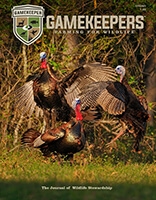Photos and Text by: Tes Randle Jolly
Ah, spring is finally here to induce Nature’s rebirth and trigger our turkey hunting passion. For us turkey hunters, it calls to mind sunlit love-struck strutters and beckoning gobbles rattling the woods. For wild turkey flocks, love is in the air. Actually, hormone-fueled toms have been strutting and gobbling for weeks with one intention—attract and breed as many hens as possible. This surge in wild turkey mating behavior plays out across the landscape, though most hens largely ignore the early overtures and become receptive later as daylight lengthens in the photoperiod.
As hunters, we’re irresistibly attracted to the heart-hammering beauty of a strutting tom’s courtship displays. When observed closely in its entirety, however, the wild turkey courtship and breeding ritual is played out over weeks, with an intricate and intriguing set of distinct behaviors. Thankfully, the opportunity to photograph such actions has presented itself on numerous occasions.
This column will detail the author’s field observations of turkey behavior in the courtship and breeding periods. Scientific insight and research data including clutch paternity studies are provided by wild turkey expert and researcher, Dr. Michael J. Chamberlain, PhD., Terrell Distinguished Professor of Wildlife Ecology and Management at Warnell School of Forestry and Natural Resources at the University of Georgia.
Wild Turkey Courtship Displays and Gobbling Behavior

Tes Jolly
The most prominent courtship behavior is the gobble. It’s the tom’s way of telegraphing his presence to attract hens over a great distance. Toms seem to be more vocal on the roost in the lead-up to the breeding period. In the absence of hunting pressure, weather events or other factors, the season’s first peak gobbling period tends to coincide with the attraction and breeding of hens that are just starting to become receptive. Conversely, as most turkey hunters know, a lack of gobbling during this time may also be influenced by the presence of hens. Henned up gobblers don’t need to be vocal and courtship can be a quieter, close-range affair.
Last year, as winter was ending, flocks segregated by sex, rejoined and regrouped into smaller social flocks for the upcoming breeding period. I spent most days from early February through March photographing one of those flocks.
Dr. Chamberlain reports that male testosterone levels gradually rise in late winter. This is normal as toms should become receptive to breeding before hens so as to begin displaying and finish sorting dominance hierarchies before the onset of breeding.
Most mornings roosted toms held a gobble fest spurred on by excited hen calls. They were usually the first ones on the ground snapping into full strut as the flock gathered for the day. Toms strutted around the hens in an intricate avian ballet of stunning visual and vocal displays. Drooping snoods, beards swinging, caruncles engorged, wide spread fans swiveled and wing tips dragged the ground. At the end of each three to four step move, their beards swinging, the strutters pirouetted for the hens. In mid-February hens were mostly aloof to the spectacular performances. By mid-March increased daylight breeding urges were triggered and receptive behaviors began.
Jakes were in the mix mainly as spectators, gobbling on the roost and strutting on the flock’s fringes. Generally, jakes don’t contribute to the breeding period but can be disrupters when larger gangs harass outnumbered toms.
Dr. Chamberlain: “Hens are capable of producing clutches as juveniles (less than one-year-old) and many do so although nest success is typically lower than for adults. A small percentage of jakes are capable of fertilizing clutches, but research shows that most are not, and jakes typically do not participate in breeding although they will attempt to copulate with hens.”
How Hens Choose Mates: Plumage, Strutting, and Vocalizations

Tes Jolly
In the turkey world the hen chooses her mate based on the tom’s vocalizations, elaborate plumage and strutting displays. She’s a tough judge with specific criteria. Dr. Chamberlain’s studies show that hens can discern the most fit toms using a combination of snood length and iridescence.
One lucky day I was in close proximity to observe and photograph a tom and hen’s courtship and mating behaviors. March’s backdrop for the tom’s overtures was sunlit clover and yellow buttercup blooms. For nearly three hours the feathered Romeo did his best to charm the hen in a dazzling courtship dance.
The hen went about her usual daily routine, unresponsive to the love-struck tom. At midmorning the pair moved to the shade of an oak. The persistent strutter, fan swiveling, circled the hen in tight circles slightly brushing her. The hen’s demeanor changed. Darting a few steps, she stopped to stand directly in his path, gazing downward. This signaled she had judged the tom worthy to mate. The tom’s sexual excitement reflected in his swollen crown, elongated snood and white caruncles. The hen lowered to the ground and the tom mounted her back.
Dr. Chamberlain: “It’s well established that dominant toms within populations secure a disproportionate percentage of breeding opportunities. Recently completed work shows a pronounced reproductive skew when looking at parentage within hatched clutches, wherein we see a small percentage of toms fathering a large percentage of clutches.”
Turkey Mating Explained: Treading and the Cloacal Kiss
Treading is an interesting behavior in the turkeys’ breeding ritual. Once a tom steps onto the hen’s back he does a brief balancing act before breeding takes place. However, this tom treaded the hen’s back for six and a half minutes during which the hen’s head was erect. After a couple of minutes, the tom’s drooping snood and caruncles engorged to deep red. Similar to other occasions when observing prolonged treading behavior, the hen emitted several high-pitched squeals, the sound similar to a squeeze toy. I can only speculate but it seemed to be caused by the hen’s inhale/exhale struggle with 20 plus pounds of tom pinning her to the ground.
Copulation began when the hen leaned forward with wings open, lowered her head to the ground and raised her tail to expose the cloaca. The tom clamped his toes over the hen’s wings and lowered his body, angled his tail sideways to expose his cloaca and rubbed it against the hen’s in what’s termed as the cloacal kiss.
What’s a cloaca? It’s a chamber found in both sexes that opens to the outside at the vent. During mating season, the cloacal openings of both sexes swell, protruding somewhat from their bodies. Here’s where it gets interesting. The birds’ reproductive tracts, urinary tracts and digestive tracts all empty into the cloaca. They have testes and ovaries but how the eggs and sperm move around is different than mammals. The oviduct in hens empties into her cloaca. During mating, the tom’s sperm, which is stored in his cloaca, is deposited into the hen’s cloaca where it travels into the oviduct, is stored, and eventually fertilizes the eggs through the laying period.
Dr. Chamberlain: “A single tom will copulate multiple times a day if allowed. Sperm remain viable in the sperm storage tubules for about 30 days after copulation, but their viability does decline slowly through time.”

Tes Jolly
Reproductive Skew and Clutch Genetics in Wild Turkeys

Tes Jolly
Once mating was accomplished the tom unceremoniously stepped off the hen and quickly resumed strutting, hoping for another opportunity. The disheveled hen stood, gathered herself, shook the dust off, smoothed ruffled feathers and went about her day. I thought what an incredible encounter, but more so, how amazingly sturdy the hen’s body is to withstand a six-minute back massage by the gnarly feet of a 20-pound tom. I was breathless just watching!
Do hens continue to breed during the egg-laying period?
Dr. Chamberlain: “Hens will continue to copulate once they’ve entered the egg-laying period. This period represents a time of increased competition amongst toms, which research shows coincides with increases in gobbling activity. If a tom copulates with a hen during egg laying, there is an increased probability that he will be represented genetically in her clutch, which explains the increase in competition as there are fitness advantages for toms to breed with hens once those hens have entered the egg-laying period.”
Multiple Paternity in Turkey Nests
Genetic studies on hatched clutches have revealed interesting findings concerning paternity. Dr. Chamberlain: “Recently completed genetic analyses of eggshell membranes from hatched clutches has allowed us to identify toms that fertilize clutches. What we’ve observed is that about 60% of clutches are fertilized by a

Tes Jolly
single tom, whereas 40% of clutches contain at least two toms and we’ve seen one instance of seven toms represented in a single clutch. We’ve observed what’s called reproductive skew, wherein a significant number of clutches in populations are fertilized by a small percentage of toms, which makes sense given the pronounced dominance hierarchies that we know are present in wild turkey flocks.”
Final Thoughts: The Wild Turkey’s Mating Dance
As turkey hunters, the strutter’s stunning courtship displays fire our passion. He’s the star of the show, however, much credit goes to the hen for her innate ability to select the fittest, dominant mate—the critical first step to the year’s poult recruitment effort.







